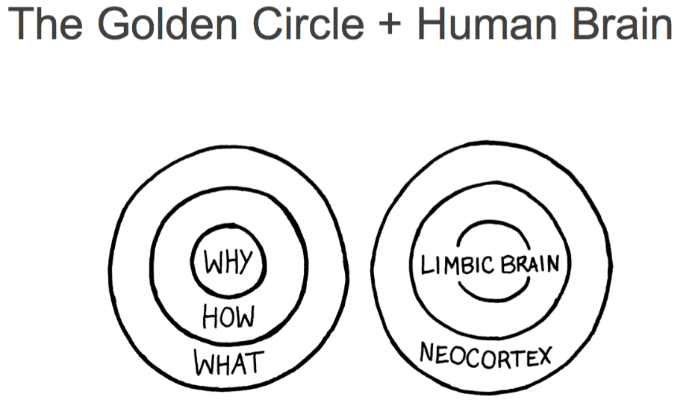For those who don't know him, Simon Sinek is a British-American author, a speaker, an ex-marketer and organizational consultant. Simon came up with the Golden Circle theory, which you can use as a starting point to write good content. By applying Simon Sinek's Golden Circle the right way, you can increase your conversions!
Simon Sinek's Golden Circle is all about how companies think and communicate between themselves and their target audience. He shows in his theory that the "why" is the most important element in communication. His motto also reads, "Start with why." He even created his website dedicated to it. The Golden Circle was created after Simon studied and analyzed world's most prominent and inspiring leaders and organizations. Then he discovered that they owe their success to the way they think, act and communicate. Namely, they communicate from the "why" rather than the "what."
The Golden Circle by Simon Sinek
Readers often end up on a blog or website when they search from a problem/need. It is therefore important that you provide (a concrete) answer in your content. Simon Sinek's Golden Circle can help with this. Answer the question in the right order (according to Simon) so that you stimulate conversion. Why can you help them, how do you do that and with what?
We dive a little further into Simon's theory....
Simon Sinek compares the human brain to a Golden Circle. The "what," the outer circle, can be compared to the Neocortex. This is your language part, our conscious level. This part contains the rational and analytical thoughts. But this is only a small part (20%) of the center. The "what" describes what you offer, such as the product or a service.
80% of the brain part is non-language. The "how" and the "why" correspond to the limbic (non-language) part of the center, your subconscious level. This part is responsible for your feelings and emotions, from here you make decisions (you know, a gut feeling) that you then try to rationalize in the cortex.
The "how" describes how you offer the product/service and why it is better than the competitor's. The "why" describes why you offer readers the product/service. And that's not because you want to make money, that's the ultimate (desired) result. It answers the "what's in it for me" question, so to speak.
One company that communicates this way is Apple. Simon Sinek also uses this as an example in his TED presentation, among others:
Many companies communicate from the "what," but...
We don't make decisions from the "what"
When you write your blog/content from the "what," you appeal to the rational part of your readers. The part where they don't make a decision whether to click the call-to-action button and leave their information. They understand the information, but it doesn't drive conversion. In other words, it doesn't benefit you that much.
When you write from the "why" you immediately address the part of the brain that deals with decisions. Then that part communicates with the language part in which someone then rationally tries to explain why that person is making that choice. Which often doesn't really work because it's actually a decision made based on a feeling you get. And this feeling you as a writer can influence! For example, the feeling of confidence that your product/service really works.
So communicate from the inside out. Start with the "why" in which you describe why people should register for something, for example, such as a training course or to download an e-book.
What does it benefit the customer and how does it help the customer with his or her problem/need. You should inform potential customers clearly and honestly about why your product/service can help with the problem/need. When you can convince the reader so much that you are giving them something valuable, they are willing to give you something in return namely their contact information :).

